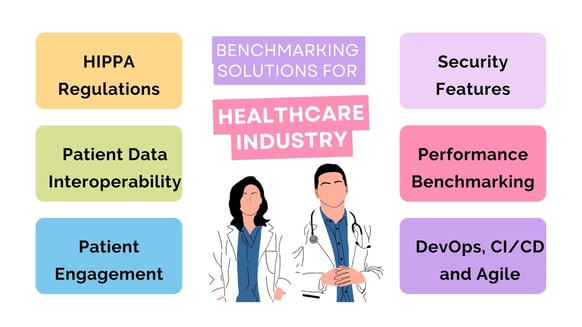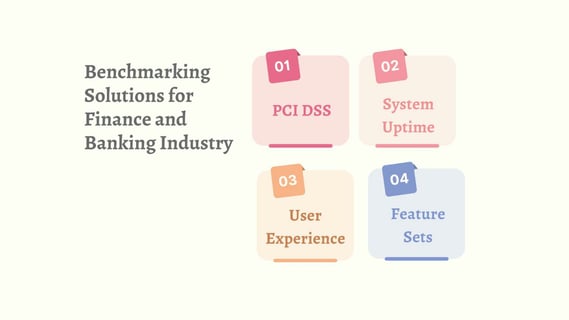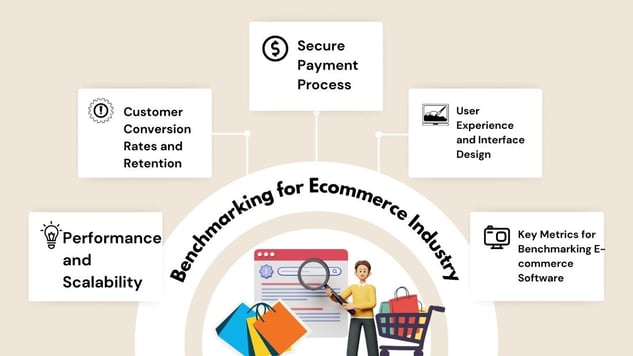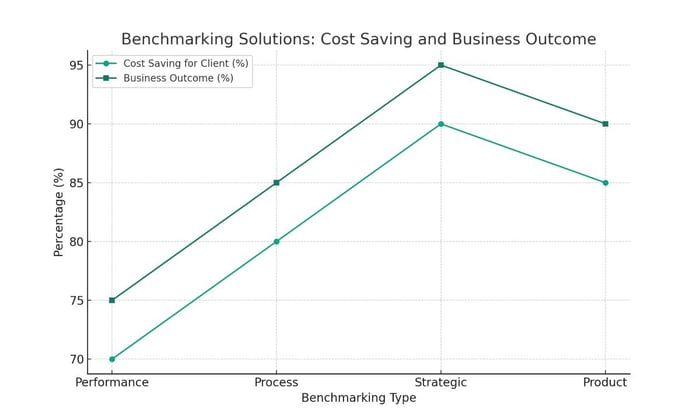Explore our expert insights on benchmarking solutions across industries and embrace the future of software development.
Blog Overview: This blog explores how businesses can benefit from our benchmarking solutions for clients from different industries in software development. We share our experiences implementing these solutions to help clients evaluate their processes/products, identify gaps, and implement industry standards and compliances, which can help them create a unique value proposition to differentiate themselves from their competitors.
The future of software development is exciting as project management practices have evolved. With so many advances, businesses need to stay competitive and innovative. This is where benchmarking comes into the picture.
What is Benchmarking?
Why do businesses need benchmarking solutions? Businesses need industry benchmarking to evaluate and compare performance and understand how well they are doing compared to their competitors. It also helps them understand what the best companies in their industries are doing and functioning and how to bridge the gaps and challenges hindering their growth.
Why and when is Benchmarking the most effective solution? It is effective when done with a clear understanding of what makes your business valuable, and it's helpful because it differentiates your business from your competitors.
Key Data Insights:
According to a McKinsey Report in 2023, implementing benchmarking helped companies to make the following improvements:
- 20%-30% reduction in customer-reported product defects
- 20% improvement in employee experience scores.
- 60% improvement in customer satisfaction rating.
Key Benchmarks Across Various Industries:
Here are in-depth insights from our experts explaining the process, the pain points, and the solutions that benchmarking solutions offer clients from various industries - healthcare, banking and finance, and E-commerce.
#1. Healthcare:

Expert Insights: Benchmarking Solutions for our Clients from the Healthcare Industry
Ensuring Compliance with HIPPA Regulations:
Every client from the healthcare industry does not need a HIPPA-compliant product. The first thing is understanding the nature of the application or project. We need to check if the client or their app offers services that require "Patient Information" - PI Data. If any PI data is involved, i.e., captured, stored, or processed, we require HIPPA compliance. Protecting PI data is very important in healthcare, and US laws protect it. This data cannot be publicly available; it must only be available to physicians or people diagnosing that cause.
Measures to Improve Patient Data Interoperability:
Encryption is meant to authenticate the data. For example, if two people exchange messages, only those two can read the messages, not the rest of the world. We encrypt the data that is in motion and the data that is at rest. It is real-time data transmitted, e.g., data is transmitted from a server to a physician's computer or laptop.
Benchmarking for Enhancing Patient Engagement:
We have an example of a use case where we provide home-based care. These people need medical care at home. A person appointed arrives for a visit for the required medical care. We provide all the required data ahead of time, with or without internet, with real-time data, like an app working both offline and online. It works on phones and tablets. These devices are registered with the agency where we send the data.
Benchmarking for Security Features in Healthcare Applications:
Firstly, there are various agencies that have well-known benchmarking standards; we match up to these standards every quarter. NIST, HIPPA, EVV (Electronic Visit Verification) certification—we have to check all the boxes to the standards that they have prescribed.
The second important thing is server compliance. We must ensure that the data you are working for HIPPA stays in the government data cloud, not the public cloud, as it is more secure. Amazon provides a government data cloud that meets the standards for compliance.
Lastly, internal auditing is required on a regular basis. We have a cycle of every four months, where we check whether all the encryptions are working and ensure all the stored data is secured. We also ensure all APIs we have are secured. If something is incorrect, immediate fixes are recommended and done.
Tools and Technologies for Performance Benchmarking:
Vulnerability assessment tools—VATB tools, we run a scan on the application, right from the operating system to the network layer to the application layer. Some of the tools we use are SNYQ, OS. We ensure our code quality is uptick, so we always use SonarQube at every development level.
Using Agile Adoption and DevOps in Benchmarking Solutions:
DevOps, CI/CD and Agile are a combination of activities that work in chronology. We align it with development activity and release activity. From a metrics point of view - we capture DORA metrics, which are indicators of how often you release, detect a failure, and how fast you can overcome that failure. We can capture it manually or in an automated way by embedding DORA metrics or tools, like Devlake, which is highly recommended in your pipeline. These are benchmarks that give good data about your operations.
"Benchmarking in the healthcare industry is not just about meeting standards; it's about setting new ones. It helps businesses and organizations from the healthcare industry improve patient care, ensure data security, and drive innovation where precision and reliability can save lives."
- Vinit Sharma, Technical Architect.
#2. Finance and Banking

Expert Insights: Benchmarking Solutions for our Clients from the Finance and Banking Industry:
Benchmarking Practices with PCI DSS and other Financial Regulatory Requirements:
We have to align benchmarking practices and other financial regulatory requirements. We implement strict data security measures across all operations that handle credit card information. This means establishing robust network security, including firewall encryption, ensuring data protection through controlled access, and maintaining vigilance with regular monitoring and testing.
We need to adhere to these standards to avoid fines and reputational damage. This is why we need to integrate PCI DSS compliance into the core of benchmarking practices to safeguard cardholder security.
Ensuring High System Uptime and Reliability in Financial Applications:
By following regulatory compliance, we can maintain financial applications' reliability and uptime and gain user trust. We use strategies like redundancy across hardware, network, and software layers, load balancing to distribute traffic, and design for scalability using cloud technologies.
Use case for Benchmarking Enhanced User Experience:
In one of our projects for a client, we enhanced transaction security and fraud detection to evaluate current practices, compare them with industry standards, and implement improvements. We took several steps to check existing security measures, benchmark against standards like PCI DSS and peer organizations and conducted a gap analysis to prioritize enhancements. We recommend training staff, monitoring performance metrics, and continuously updating security measures for effective fraud prevention.
Businesses must embrace the future of software development and trends while benchmarking by investing in emerging technology trends like artificial intelligence and machine learning, implementing Multifactor authentication (MFA), developing behavior analytics, and participating in fraud intelligence sharing networks.
Benchmarking and Implementing Competitive Feature Sets in Financial Software:
Benchmarking is crucial in developing competitive feature sets for financial software, providing insights into industry trends, best practices, and competitor offerings. It helps identify popular features, assess competitor strengths and weaknesses, and establish performance benchmarks. By prioritizing feature development based on user demand and market trends, development teams can effectively innovate and differentiate their software. Additionally, benchmarking validates development decisions and ensures alignment with market expectations. Overall, leveraging benchmarking data empowers development teams to deliver software with a competitive edge that meets user needs and industry standards.
"Benchmarking in banking and finance is about setting the pace—ensuring our financial services lead with security, user experience, and cutting-edge features that redefine customer expectations and industry standards."
- Tharun Kumar, Sr. System Analyst.
#3. E-commerce:

Expert Insights: Benchmarking Solutions for our Clients from the E-commerce Industry:
Benchmarking Performance and Scalability for High-traffic E-commerce Platforms:
In order to benchmark an e-commerce website, we have to check various aspects of its performance to ensure optimal functionality and user experience. The parameter for performance optimizationare:
a. Page Load Time: Page load time plays a vital role in success and effectiveness of any e-commerce website. If certain sections of the website takes more time to load then customers will loose interest in to browse the site further. On the other hand, we pages load faster then their are more number of visitors, which improves the success rate of effective use of website.
b. Site availability and uptime: The percentage of the time website is accessible and operational plays a crucial role in success.
c. Infrastructure fine tuning: It is important to fine tune infrastructure where the site is hosted. Because the better optimized your web servers the better is processing and ease of use. The server should also be optimally configured to deal with sudden spike in usage and bandwidth. If there are less users then the server shoulduse optimal resources.
d. Well defined site accessibility and usability: It ensures inclusivity, legal compliance, also helps people with disabilities can use your product while meeting regulatory standards. With usability, you can enhance user experience and improve satisfaction, SEO performance, and brand reputation, ultimately reaching a broader audience and reducing support costs. Investing in accessibility and usability enhances user satisfaction and ensures relevance and effectiveness.
Improving Customer Conversion Rates and Retention E-commerce Clients:
Implementing the insights gained from benchmarking, we embarked on a series of optimizations, including code refactoring, image compression, and server-level tuning. These efforts resulted in improved load times, which ensured users could browse website effortlessly, without delay.
Benchmarking checkout process againt industry standards and leading competitors helps identify enhancements and streamline the path to purchase and minimized friction for our customers.
Strategies to Ensure a Seamless and Secure Payment Process:
a. Industry Standards Compliance: Implementing payment Card Industry Data Security Standard (PCI DSS), ensures that your payment system meets or exceeds standards for data security and compliance.
b. User experience benchmarking: Benchmark factirs such as checkout flow, payment method options, and ease of use.
c. Fraud Prevention and Detection: Benchmark your fraud prevention and detection measures against industry best practices and leading competitors. Ensure that your payment process includes robust security features such as encryption, tokenization, and real-time fraud monitoring.
d. Transcation Success Rates: Monitor transaction success rates and benchmark them against industry averages and leading compititors. Identify issues or bottlenecks in the payment process that cause transaction failures or declines and take corrective action.
e. Payment Method Support: Benchmark your support for different payment methods against standards and leading competitors. Ensure that your payment process offers a wide range of payment options to accommodate diverse customer preferences and needs.
Influence of Benchmarking on User Experience and Interface Design:
Benchmarking for UX and UI involves evaluating the site navigation and layout's intuitiveness, attractiveness, and efficiency. This is often done through user testing and comparing with best-in-class e-commerce sites.
We conducted usability testing and benchmarked against best e-commerce platforms to redesign a client's product discovery and filtering interface. The new design, inspired by best practices in facilitating user navigation and decision-making, resulted in a 25% increase in user engagement and a significant boost in sales.
Key Metrics for Benchmarking E-commerce Software Against Competitors:
When benchmarking e-commerce software against competitors, the focus is often on:
- Page load times and site speed.
- Mobile responsiveness and app performance.
- Conversion rate optimization metrics, including cart abandonment rates.
- User engagement metrics, such as time on site and pages per session.
- Security features and compliance with standards like PCI DSS for payments.
In a project to benchmark an e-commerce platform against its competitors, we focused on mobile performance metrics, recognizing the increasing trend of mobile shopping. By improving the mobile site's speed and responsiveness, the client saw a 40% increase in mobile traffic and a 30% increase in purchases made from mobile devices.
"Benchmarking for e-commerce platforms is about analyzing and adapting to the speeds, standards, and strategies. Through diligent benchmarking, we set the stage for unparalleled user experiences, higher conversion rates, and sustained growth in the competitive e-commerce landscape."
- Aashish Sonawane, Technical Leader.
Main Reasons for Client's Interest in Benchmarking:
- To reduce costs and optimize resource use in software development.
- Businesses need to check the efficiency of their suppliers or internal team performance.
- Companies focused on continuous improvement.
- Keen on showcasing the positive impacts of recent improvements.
- Organizations looking to embed or streamline changes within their development processes.
How our Clients Utilized our Benchmarking Solution:
|
Industry |
Compliance and Security |
Interoperability Standards/Payment Security |
Patient/Client Experience and Engagement |
|---|---|---|---|
|
Healthcare |
HIPAA/GDPR compliance, encryption, data access controls, audit trails |
HL7/FHIR standards for data exchange |
Patient portals, telehealth, wearable tech usability |
|
Finance and Banking |
PCI DSS compliance, encryption, transaction security, fraud detection |
High system uptime, fast transaction processing |
Mobile banking UX, feature innovation, customer service integration |
|
E-commerce |
Payment processing security, customer data protection |
High traffic and peak load management |
UX design, personalization, seamless payment pro |
Common Issues in Software Development Benchmarks Across Industries:
- Agile adoption and DevOps practices: Implementing metrics related to adopting agile methodologies and DevOps practices, focusing on deployment frequency, change lead time, and mean time to recovery.
- Code Quality Maintainability: Benchmarking for code quality, including defects rates, code coverage, and technical debt ratios.
- Innovation and time-to-market: Setting these metrics helps check a company's ability to innovate and bring products to the market quickly compared to competitors.
Benchmarking Solutions We Offer Our Clients:
The line graph shows the percentage of cost savings and positive business outcomes across different types of benchmarking solutions. Each benchmarking solution shows how it improves our clients' cost savings and business outcomes.

Here's a table to summarize the graph above:
|
Benchmarking Type |
Cost Saving for Client |
Business Outcome |
|---|---|---|
|
Performance Benchmarking |
Reduced site abandonment, improved conversion rates |
Enhanced user experience, operational efficiency |
|
Process Benchmarking |
Efficiency in development processes, reduced time to market |
Process optimization, agility in software development |
|
Strategic Benchmarking |
Insight-driven strategic investments, higher market share |
Innovation leadership, competitive advantage |
|
Product Benchmarking |
Increased customer retention, enhanced brand loyalty |
Product superiority, competitive usability |
What are the Benefits of Benchmarking Software Development Processes for Businesses?
- Benchmarking allows businesses to understand how they compare to competitors in key performance areas. By measuring the best in the industry, companies can set high-performance standards and strive not just to meet the benchmark but to excel.
- Benchmarking customer service and product quality against industry leaders can highlight areas for improvement in customer satisfaction and loyalty, which is crucial for business growth.
- Benchmarking can uncover strategies and processes that lead to increased market share and revenue growth. Benchmarking operational processes and efficiency can lead to significant cost savings by identifying more cost-effective methods of operation, procurement, production, and delivery.
- Benchmarking fosters a culture of continuous improvement and excellence within the organization by setting clear targets and monitoring progress.
Recommendations From Our Experts:
1. Regularly improve processes based on industry benchmarks, fostering a culture of continuous improvement.
2. Align benchmarks with customer expectations to enhance satisfaction by prioritizing customer feedback.
3. To value employee engagement, link employee satisfaction with product quality and include it in benchmark metrics.
4. Use data analytics for improve decision-making and to set goals to drive data-driven decision making.
5. Invest in technology after using efficient tools for benchmarking and insight gathering.
6. Collaborate with industry peers, and leaders to adopt best practices.
7. Equip your team with best knowledge on industry standards.
Hire Developers for Benchmarking Solutions:
Hire developers to implement benchmarking solutions to be on par with the future of software development trends and also excel in ongoing events like remote work, cyber security and risks, the increasing demand for healthcare, banking and finance, and e-commerce software.
These trends are changing software development and influencing the cost of hiring software developers. Businesses find outsourcing software development a viable option for managing costs and partnering with a reliable offshore software development team. This shift reflects the need to stay competitive. As businesses navigate evolving challenges, they need to find the right balance between cost, quality, and security to leverage software development across industries.









